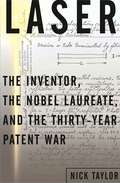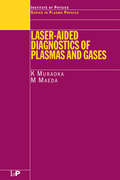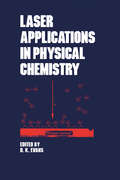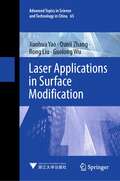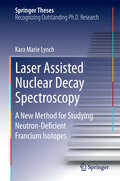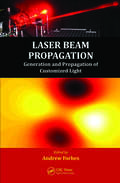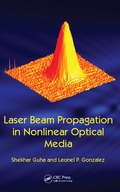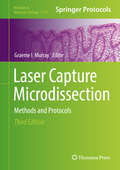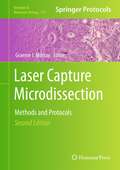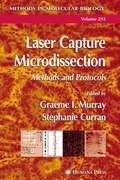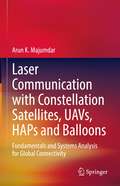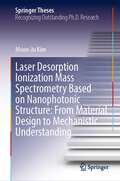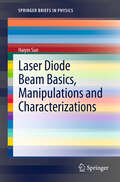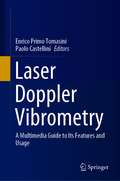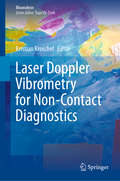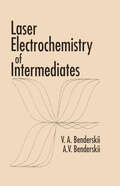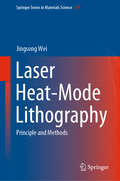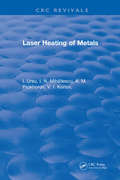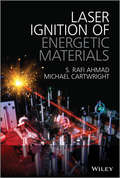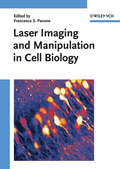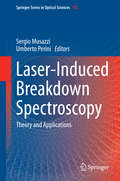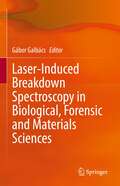- Table View
- List View
Laser: The Inventor, the Nobel Laureate, and the Thirty-Year Patent War
by Nick TaylorIn 1957 Gordon Gould, then an obscure physicist and perennial graduate student, conceived one of the revolutionary inventions of the twentieth century -- the laser. But before he could submit a patent application, a prominent professor of physics whose office was next door to Gould's filed his own laser patent claims. Gould fought to reclaim the rights to his work, beginning a battle that would last nearly thirty years. Many millions of dollars, as well as the integrity of scientific claims, were at stake in the litigation that ensued. Laseris Gould's story -- and an eye-opening look at the patent process in America, the nexus of the worlds of business and science. Gould was struggling to finish his Ph. D. thesis when he struck upon the concept for the laser, or Light Amplification by Stimulated Emission of Radiation. Light waves, Gould realized, would form a single concentrated beam when reflected between two mirrors inside a gas-filled chamber. Even as he was sketching his invention, Gould foresaw the tremendous potential of the laser in industry, communications, and the military. For three days he feverishly documented his ideas in a notebook, which he had notarized in a candy store near his Bronx apartment. A small technology firm took a great interest in Gould's laser and soon won a Defense Department contract to develop lasers for the military. Ironically, Gould was denied a security clearance because of his past communist associations, and so was unable to work on his own invention. He could only watch from the sidelines as colleagues tried to build a working laser in a desperate race with larger, better-funded research labs. Meanwhile, Gould's rival, Charles Townes, had everything that Gould lacked, most notably important academic and government appointments and esteem in the scientific community. In the dispute between the two men, few doubted Townes's word, while nearly everyone scoffed at Gould's claims. But Gould's determination was unyielding, and he fought everyone who stood in his way, including the U. S. Patent Office, major corporations, and the entire laser industry, until he finally won. Gordon Gould, the courts ruled, had invented the laser. Laseris a grand story of technology and law. Nick Taylor has extensively interviewed Gould as well as other key participants in the battle over the laser's invention and patents. In this riveting account of genius, rivalry, and greed, he shows just how difficult it is for the legendary lone inventor to prevail when the license to a valuable invention is at stake.
Laser-Aided Diagnostics of Plasmas and Gases (Series in Plasma Physics)
by K Muraoka M MaedaUpdated and expanded from the original Japanese edition, Laser-Aided Diagnostics of Gases and Plasmas takes a unique approach in treating laser-aided diagnostics. The book unifies the subject by joining applications instead of describing each application as a totally separate system. In taking this approach, it highlights the relative strengths of
Laser Applications in Physical Chemistry
by D.K. EvansThis book provides an introduction on applications of lasers in Chemistry. It describes laser as a tool for chemistry, the consideration involved in describing a laser beam and what happens to beam as it is propagated through a gas. The book is useful for graduates and advanced undergraduates.
Laser Applications in Surface Modification (Advanced Topics in Science and Technology in China #65)
by Jianhua Yao Qunli Zhang Rong Liu Guolong WuThis book introduces the applications of laser in surface modification, such as laser cladding of Stellite alloys and metal-ceramic composites. Besides, nanomaterials including carbon nanotubes and Al2O3 nanoparticles are brought into the laser processing, to form high-temperature resistance, chemical stability, and wear- and oxidation-resistant composite coatings. The readers will get more knowledge about the basic principle and application of laser cladding and laser surface hardening technologies, and gain a deep insight into the process and characteristics of the nanomaterial-assisted laser surface enhancement. It provides references for the researchers, engineers, and students in the fields of mechanical engineering, laser processing, and material engineering.
Laser-Assisted Fabrication of Materials
by Indranil Manna Jyotsna Dutta MajumdarLaser assisted fabrication involves shaping of materials using laser as a source of heat. It can be achieved by removal of materials (laser assisted cutting, drilling, etc.), deformation (bending, extrusion), joining (welding, soldering) and addition of materials (surface cladding or direct laser cladding). This book on ´Laser assisted Fabrication' is aimed at developing in-depth engineering concepts on various laser assisted macro and micro-fabrication techniques with the focus on application and a review of the engineering background of different micro/macro-fabrication techniques, thermal history of the treated zone and microstructural development and evolution of properties of the treated zone.
Laser Assisted Nuclear Decay Spectroscopy
by Kara Marie LynchThis work details an application of collinear resonance ionization spectroscopy for the separation of short-lived isomeric states and their subsequent study with decay spectroscopy. It reports the successful construction of a novel decay spectroscopy apparatus that can operate at pressures below 1 x 10^-9 mbar. The method is demonstrated by separating the nuclear ground and isomeric states of 204Fr and performing alpha-decay spectroscopy. An equivalent mass spectrometer would require 4. 6 million times as much resolution to achieve the same result. This work unambiguously confirms the existence of a second isomeric state in 204Fr. The author also demonstrates the effectiveness of this method for laser spectroscopy and identification of hyperfine-structure components with energy tagging. This method was successfully used in 202Fr to identify ground and isomeric states. The measurement of 202Fr reported in this thesis demonstrates a factor of 100 improvement in sensitivity compared to state-of-the-art fluorescence techniques. The work reported in this thesis won the author the IOP Nuclear Physics Group Early Career Prize.
Laser-Based Measurements for Time and Frequency Domain Applications: A Handbook (Series in Optics and Optoelectronics)
by Pasquale Maddaloni Marco Bellini Paolo De NataleForeword by Nobel laureate Professor Theodor W. H�ch of Ludwig-Maximilians-UniversitätMunchenBased on the authors' experimental work over the last 25 years, Laser-Based Measurements for Time and Frequency Domain Applications: A Handbook presents basic concepts, state-of-the-art applications, and future trends in optical, atomic, and molecular physic
Laser Beam Propagation: Generation and Propagation of Customized Light
by Andrew ForbesHow do laser beams propagate? Innovative discoveries involving laser beams and their propagation properties are at the heart of Laser Beam Propagation: Generation and Propagation of Customized Light. This book captures the essence of laser beam propagation. Divided into three parts, it explores the fundamentals of how laser beams propagate, and pro
Laser Beam Propagation in Nonlinear Optical Media
by Shekhar Guha and Leonel P. Gonzalez"This is very unique and promises to be an extremely useful guide to a host of workers in the field. They have given a generalized presentation likely to cover most if not all situations to be encountered in the laboratory, yet also highlight several specific examples that clearly illustrate the methods. They have provided an admirable contribution to the community. If someone makes their living by designing lasers, optical parametric oscillators or other devices employing nonlinear crystals, or designing experiments incorporating laser beam propagation through linear or nonlinear media, then this book will be a welcome addition to their bookshelf."—Richard Sutherland, Mount Vernon Nazarene University, Ohio, USA Laser Beam Propagation in Nonlinear Optical Media provides a collection of expressions, equations, formulas, and derivations used in calculating laser beam propagation through linear and nonlinear media which are useful for predicting experimental results. The authors address light propagation in anisotropic media, oscillation directions of the electric field and displacement vectors, the walk-off angles between the Poynting and propagation vectors, and effective values of the d coefficient for biaxial, uniaxial, and isotropic crystals. They delve into solutions of the coupled three wave mixing equations for various nonlinear optical processes, including quasi-phase matching and optical parametric oscillation, and discuss focusing effects and numerical techniques used for beam propagation analysis in nonlinear media, and phase retrieval technique. The book also includes examples of MATLAB and FORTRAN computer programs for numerical evaluations. An ideal resource for students taking graduate level courses in nonlinear optics, Laser Beam Propagation in Nonlinear Optical Media can also be used as a reference for practicing professionals.
Laser Capture Microdissection
by Graeme I. MurrayLaser microdissection techniques have revolutionized the ability of researchers in general, and pathologists in particular, to carry out molecular analysis on specific types of normal and diseased cells and to fully utilize the power of current molecular technologies including PCR, microarrays, and proteomics. In second edition of Laser Capture Microdissection: Methods and Protocols, experts in the field provide the reader with practical advice on how to carry out tissue-based laser microdissection successfully in their own laboratory using the different laser microdissection systems that are available and to apply a wide range of molecular technologies. The individual chapters encompass detailed descriptions of the individual laser based micro-dissection systems. The downstream applications of the laser microdissected tissue described in the book include PCR in its many different forms as well as gene expression analysis including application to microarrays and proteomics. Written in the highly successful Methods in Molecular Biology(tm) series format, chapters include introductions to their respective topics, lists of the necessary materials and reagents, step-by-step, readily reproducible laboratory protocols, and tips on troubleshooting and avoiding known pitfalls. Authoritative and cutting-edge, Laser Capture Microdissection: Methods and Protocols, Second Edition is an ideal resource for researchers striving to move forward our understanding of normal physiology and pathology.
Laser Capture Microdissection
by Graeme I. MurrayLaser microdissection techniques have revolutionized the ability of researchers in general, and pathologists in particular, to carry out molecular analysis on specific types of normal and diseased cells and to fully utilize the power of current molecular technologies including PCR, microarrays, and proteomics. In second edition of Laser Capture Microdissection: Methods and Protocols, experts in the field provide the reader with practical advice on how to carry out tissue-based laser microdissection successfully in their own laboratory using the different laser microdissection systems that are available and to apply a wide range of molecular technologies. The individual chapters encompass detailed descriptions of the individual laser based micro-dissection systems. The downstream applications of the laser microdissected tissue described in the book include PCR in its many different forms as well as gene expression analysis including application to microarrays and proteomics. Written in the highly successful Methods in Molecular BiologyTM series format, chapters include introductions to their respective topics, lists of the necessary materials and reagents, step-by-step, readily reproducible laboratory protocols, and tips on troubleshooting and avoiding known pitfalls. Authoritative and cutting-edge, Laser Capture Microdissection: Methods and Protocols, Second Edition is an ideal resource for researchers striving to move forward our understanding of normal physiology and pathology.
Laser Capture Microdissection
by Graeme I. Murray Stephanie CurranExpert laboratorians noted for their optimized methods describe in step-by-step detail how to successfully carry out tissue-based laser microdissection in their own laboratory using the different systems available and to apply a wide range of sophisticated molecular technologies to the microdissected tissue samples. Highlights include gene expression profiling of primary tumor cell populations using laser capture microdissection, RNA transcript amplification and GeneChip® microarrays, laser capture microdissection and colorectal cancer proteomics, and proteomic analysis of human bladder tissue using SELDI® approach following microdissection techniques. Applications of the microdissected tissue described encompass PCR, gene expression studies including microarray analysis, and proteomics.
Laser Cleaning: Fundamentals and Applications
by Feng Song Xuechun LinThis book highlights a comprehensive summary of the latest advances in research and applications of laser cleaning. As an innovative way of surface treatment, laser cleaning has received increasing global attention in today's environmentally conscious world. Laser cleaning has gone through a long history from theories to technological developments, and to a wide spectrum of applications. The book first presents the fundamental physics of laser cleaning and demonstrates how the theories have guided the innovation of technology and applications. Following that, the new and most used equipment for laser cleaning has been introduced. Applications in electrics, paint removal, rust removal, the mold industry, cultural heritage protection, and other fields are summarized with plenty of examples and discussions. The book is a valuable reference in laser cleaning for researchers who seek inspiration for their research, engineers who need specific information to guide their work, and students who must learn systematically with working examples.
Laser Communication with Constellation Satellites, UAVs, HAPs and Balloons: Fundamentals and Systems Analysis for Global Connectivity
by Arun K. MajumdarThis book presents posits a solution to the current limitations in global connectivity by introducing a global laser/optical communication system using constellation satellites, UAVs, HAPs and Balloons. The author outlines how this will help to satisfy the tremendous increasing demand for data exchange and information between end-users worldwide including in remote locations. The book provides both fundamentals and the advanced technology development in establishing worldwide communication and global connectivity using, (I) All-Optical technology, and (ii) Laser/Optical Communication Constellation Satellites (of different types, sizes and at different orbits), UAVs, HAPs (High Altitude Platforms) and Balloons. The book discusses step-by-step methods to develop a satellite backbone in order to interconnect a number of ground nodes clustered within a few SD-WAN (software-defined networking) in a wide area network (WAN) around the world in order to provide a fully-meshed communication network. This book pertains to anyone in optical communications, telecommunications, and system engineers, as well as technical managers in the aerospace industry and the graduate students, and researchers in academia and research laboratory.Proposed a solution to the limitations in global connectivity through a global laser/optical communication system using constellation satellites, UAVs, HAPs and Balloons;Provides both fundamentals and the advanced technology development in establishing global communication connectivity using optical technology and communication constellation satellites;Includes in-depth coverage of the basics of laser/optical communication constellation satellites.
Laser Desorption Ionization Mass Spectrometry Based on Nanophotonic Structure: From Material Design to Mechanistic Understanding (Springer Theses)
by Moon-Ju KimThis book presents innovative laser desorption ionization (LDI)-active nanophotonic structures for addressing the challenges that matrix-assisted laser desorption ionization mass spectrometry (MALDI-MS) is currently facing and for enhancing LDI efficiency. It presents a variety of cutting-edge nanophotonic structures to satisfy the mass-analytical needs of sensitivity, reproducibility, and quantification. As opposed to the commercialized, conventional organic matrix used in MALDI-MS, these nanostructures are validated to be highly effective in detecting small metabolites and drugs, highlighting their considerable potential in the mass spectrometry field. It also systematically elucidates fundamental LDI processes in terms of the photo-thermal, electronic, and structural characteristics of nanophotonic structures, offering mechanistic knowledge of LDI-MS. Even though LDI-MS performance is heavily influenced by a number of nanostructure parameters, relatively little is known about the LDI processes associated with those characteristics. An in-depth understanding of nanostructure characteristics and LDI mechanisms thus paves the way for more effective, rational design and development of nanostructures with improved LDI capabilities. Further, with a focus on multiple cascades in nanostructure functions in response to laser pulse stimuli, this book provides detailed, step-by-step procedures to design and construct a nanophotonic, LDI-active platform, which may serve as a roadmap for graduate students in the field of mass spectrometry. Readers, including graduate students, researchers, and experts working in the related areas of mass spectrometry, nanophotonics, and material science and material engineering, will find a wealth of useful information in this book.
Laser Diode Beam Basics, Manipulations and Characterizations
by Haiyin SunMany optical design technical books are available for many years which mainly deal with image optics design based on geometric optics and using sequential raytracing technique. Some books slightly touched laser beam manipulation optics design. On the other hand many books on laser diodes have been published that extensively deal with laser diode physics with little touching on laser diode beam manipulations and characterizations. There are some internet resources dealing with laser diode beams. However, these internet resources have not covered enough materials with enough details on laser diode beam manipulations and characterizations. A technical book concentrated on laser diode beam manipulations and characterizations can fit in to the open and provide useful information to laser diode users. Laser Diode Beam Basics, Manipulations and Characterizations is concentrated on the very practical side of the subject, it only discusses the basic physics and mathematics that are necessary for the readers in order to understand the subject. This book is intended to provide a practical guidance and reference to those scientists and engineers who are still new to laser diode applications, and to those undergraduate and graduate students who are studying lasers and optics. Readers are expected to be able to fast and easily find the most practical and useful information about laser diodes in this book without the need of searching through a sea of information.
Laser Doppler Vibrometry: A Multimedia Guide to its Features and Usage
by Paolo Castellini Enrico Primo TomasiniThis book is a continuous learning tool for experienced technical staff facing laser vibrometry technology for the first time. The book covers both theoretical aspects and practical applications of laser Doppler vibrometry, and is accompanied by a multimedia presentation that allows the audience to browse the content and come as close as possible to performing real experiments. After a brief introduction, Chapter 2 presents supporting theory, providing general information on light sources, light scattering and interference for a better understanding of the rest of the book. Chapter 3 examines the theory of laser vibrometers, explaining interferometers from an optical perspective and in terms of the related electronics. It also addresses options like tracking filters and different signal demodulation strategies, since these have a significant impact on the practical use of vibrometers. Chapter 4 explores the configurations that are encountered in today’s instrumentation, with a focus on providing practical suggestions on the use of laser vibrometers. Lastly, Chapter 5 investigates metrology for vibration and shock measurements using laser interferometry, and analyses the uncertainty of laser vibrometers in depth.
Laser Doppler Vibrometry for Non-Contact Diagnostics (Bioanalysis #9)
by Kristian KroschelThis book presents recent outcomes of the collaborative “Tricorder” project, which brings together partners from industry, research institutes and hospitals to deliver an easy contactless alternative for electrocardiograms (ECG).Featuring contributions investigating the possible applications of laser Doppler vibrometry (LDV) signals for the remote measurement of vital parameters of the heart, the book provides insights into the vision and the history of the "Tricorder" project and the basic differences between the vibrocardiograms and electrocardiograms. It also discusses topics such as signal processing, heartbeat measurement techniques, respiration frequency and oxygen saturation determination, with a particular focus on the diagnostic value of the method presented, e.g., diagnosis of atrial fibrillation and estimation of the oxygen saturation in premature infants. Further, the authors review the advantages and drawbacks of the new method and the specific fields of application.This book will appeal to researchers and industry leaders interested in laser remote sensing for medical applications as well as medical professionals curious about new healthcare technologies.
Laser Electrochemistry of Intermediates
by Victor A. Benderskii Alexander V. BenderskiiLaser photoelectron emission not only allows investigation of interfaces between electrodes and solution, but also provides a method for fast generation of intermediate species in the vicinity of the interface and so permits study of their electrode reactions. Laser Electrochemistry of Intermediates presents the first-ever comprehensive review of this important phenomenon and its electrochemical applications.The book explores how the innovative method of laser electron emission from metal electrodes resolves two fundamental problems inherent in current methods of intermediate species (IS) generation and detection: difficulty generating IS quickly in the vicinity of the electrode surface and low IS surface concentration. In addition, for the first time, quasi-free and solvated electrons, hydrogen atoms, simple organic and inorganic radicals, and ions with anomalous valence are systematically studied. Laser Electrochemistry of Intermediates incorporates a unique, two-pronged analytical approach. First, the authors consider the kinetics and thermodynamics of the processes based on the participation of IS in its one-electron stages, thus allowing the assignment of real physical meaning to the electrochemical measurables. Second, they consider electrode reactions side by side with homogeneous reactions of electron transfer, facilitating understanding of the universal theory of electron transfer reactions in polar media as well as the peculiarities of these reactions occurring in the interface between electrode and solution.
Laser Heat-Mode Lithography: Principle and Methods (Springer Series in Materials Science #291)
by Jingsong WeiThis book provides a systematic description and analysis of laser heat-mode lithography, addressing the basic principles, lithography system, manipulation of feature size, grayscale lithography, resist thin films, and pattern transfer, while also presenting typical experimental results and applications. It introduces laser heat-mode lithography, where the resist thin films are essentially an opto-thermal response to the laser beam with changeable wavelength and are not sensitive to laser wavelength. Laser heat-mode lithography techniques greatly simplify production procedures because they require neither a particular light source nor a particular environment; further, there are no pre-baking and post-baking steps required for organic photoresists. The pattern feature size can be either larger or smaller than the laser spot by adjusting the writing strategy. The lithographic feature size can also be arbitrarily tuned from nanoscale to micrometer without changing the laser spot size. Lastly, the line edge roughness can be controlled at a very low value because the etching process is a process of breaking bonds among atoms. The book offers an invaluable reference guide for all advanced undergraduates, graduate students, researchers and engineers working in the fields of nanofabrication, lithography techniques and systems, phase change materials, etc.
Laser Heating of Metals
by A. M. ProkhorovIn order to ensure efficient use of lasers, and for any large-scale implementation, a thorough knowledge of the fundamental laws governing the interaction of radiation with matter is required. Laser Heating of Metals provides a systematic and comprehensive presentation of the fundamental principles underlying the physical and chemical mechanisms governing the interaction of laser radiation with solid targets, and in particular metals in gaseous environments, for a wide range of beam parameters. The authors have been active in the field of interactions between lasers and materials for many years, and this book summarises the results of their work, in particular concerning the action of CO2 lasers on metals. These results are then discussed at some length. Laser Heating of Materials will be of interest to scientists at all levels with an interest in the interaction of radiation with condensed matter, and in particular to those involved in laser cutting and welding etc, and metal-working.
Laser Ignition of Energetic Materials
by Michael Cartwright S Rafi AhmadThe book gives an introduction to energetic materials and lasers, properties of such materials and the current methods for initiating energetic materials. The following chapters and sections highlight the properties of lasers, and safety aspects of their application. It covers the properties of in-service energetic materials, and also materials with prospects of being used as insensitive ammunitions in future weapon or missiles systems or as detonators in civilian (mining) applications. Because of the diversity of the topics some sections will naturally separate into different levels of expertise and knowledge.
Laser Imaging and Manipulation in Cell Biology
by Francesco S. PavoneHere, the editor has gathered a team of international experts to present the latest advances in the field of laser imaging and manipulation techniques. The result is broad coverage of the interactions with biological samples to perform novel optical manipulation operations, both on the cellular and tissue levels. Of interest to physicists working and researching laser tissue mechanisms, cell biologists investigating new imaging and manipulation operation on the cellular level, medical doctors working with new laser therapies and diagnostic tools, as well as engineers developing new technologies in the field of optics and lasers.
Laser-Induced Breakdown Spectroscopy
by Sergio Musazzi Umberto PeriniThis book deals with the Laser-Induced Breakdown Spectroscopy (LIBS) a widely used atomic emission spectroscopy technique for elemental analysis of materials. It is based on the use of a high-power, short pulse laser excitation. The book is divided into two main sections: the first one concerning theoretical aspects of the technique, the second one describing the state of the art in applications of the technique in different scientific/technological areas. Numerous examples of state of the art applications provide the readers an almost complete scenario of the LIBS technique. The LIBS theoretical aspects are reviewed. The book helps the readers who are less familiar with the technique to understand the basic principles. Numerous examples of state of the art applications give an almost complete scenario of the LIBS technique potentiality. These examples of applications may have a strong impact on future industrial utilization. The authors made important contributions to the development of this field.
Laser-Induced Breakdown Spectroscopy in Biological, Forensic and Materials Sciences
by Gábor GalbácsThis book offers a comprehensive overview of recent advances in the area of laser-induced breakdown spectroscopy (LIBS), focusing on its application to biological, forensic and materials sciences. LIBS, which was previously mainly used by physicists, chemists and in the industry, has now become a very useful tool with great potential in these other fields as well. LIBS has a unique set of characteristics including minimal destructiveness, remote sensing capabilities, potential portability, extremely high information content, trace analytical sensitivity and high throughput. With its content divided into two main parts, this book provides not only an introduction to the analytical capabilities and methodology, but also an overview of the results of recent applications in the above fields. The application-oriented, multidisciplinary approach of this work is also reflected in the diversity of the expert contributors. Given its breadth, this book will appeal to students, researchers and professionals interested in solving analytical/diagnostic/material characterization tasks with the application of LIBS.
